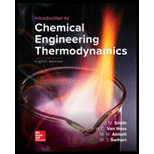
Interpretation:
The discharge temperature of isobutene and the power output of the turbine under the given conditions need to be calculated
Concept Introduction:
- For an ideal gas under isentropic adiabatic conditions, the temperature and pressure are related as:
- The isentropic efficiency of a turbine is given as:
The discharge temperature of isobutane =
Power output of turbine = -4250 kW
Given Information:
Inlet pressure, P1 = 5000 kPa
Inlet Temperature, T1=
Outlet pressure, P2 = 500 kPa
Molar flow rate = 0.7 kmol/s
Turbine efficiency, ? = 0.80
Explanation:
In this case, isobutane has been assumed to behave as an ideal gas. The discharge temperature can be deduced from equation (1) and the power output can be deduced from equation (4).
The heat capacity ratio for isobutane, i.e. ? = 1.2
Calculation:
Step 1:
Calculate the discharge/final temperature, T2
Based on equation (1) we have:
Step 2:
Calculate the actual enthalpy change
The adiabatic enthalpy change is related to the change in temperature through the specific heat capacity, Cp
Based on equation (5) the actual enthalpy change is:-
Step 3:
Calculate the power output of the turbine
Based on equation (4)
Thus, the discharge temperature of isobutane =
Power output of turbine = -4250 kW
Want to see the full answer?
Check out a sample textbook solution
Chapter 7 Solutions
Introduction to Chemical Engineering Thermodynamics
 Introduction to Chemical Engineering Thermodynami...Chemical EngineeringISBN:9781259696527Author:J.M. Smith Termodinamica en ingenieria quimica, Hendrick C Van Ness, Michael Abbott, Mark SwihartPublisher:McGraw-Hill Education
Introduction to Chemical Engineering Thermodynami...Chemical EngineeringISBN:9781259696527Author:J.M. Smith Termodinamica en ingenieria quimica, Hendrick C Van Ness, Michael Abbott, Mark SwihartPublisher:McGraw-Hill Education Elementary Principles of Chemical Processes, Bind...Chemical EngineeringISBN:9781118431221Author:Richard M. Felder, Ronald W. Rousseau, Lisa G. BullardPublisher:WILEY
Elementary Principles of Chemical Processes, Bind...Chemical EngineeringISBN:9781118431221Author:Richard M. Felder, Ronald W. Rousseau, Lisa G. BullardPublisher:WILEY Elements of Chemical Reaction Engineering (5th Ed...Chemical EngineeringISBN:9780133887518Author:H. Scott FoglerPublisher:Prentice Hall
Elements of Chemical Reaction Engineering (5th Ed...Chemical EngineeringISBN:9780133887518Author:H. Scott FoglerPublisher:Prentice Hall
 Industrial Plastics: Theory and ApplicationsChemical EngineeringISBN:9781285061238Author:Lokensgard, ErikPublisher:Delmar Cengage Learning
Industrial Plastics: Theory and ApplicationsChemical EngineeringISBN:9781285061238Author:Lokensgard, ErikPublisher:Delmar Cengage Learning Unit Operations of Chemical EngineeringChemical EngineeringISBN:9780072848236Author:Warren McCabe, Julian C. Smith, Peter HarriottPublisher:McGraw-Hill Companies, The
Unit Operations of Chemical EngineeringChemical EngineeringISBN:9780072848236Author:Warren McCabe, Julian C. Smith, Peter HarriottPublisher:McGraw-Hill Companies, The





